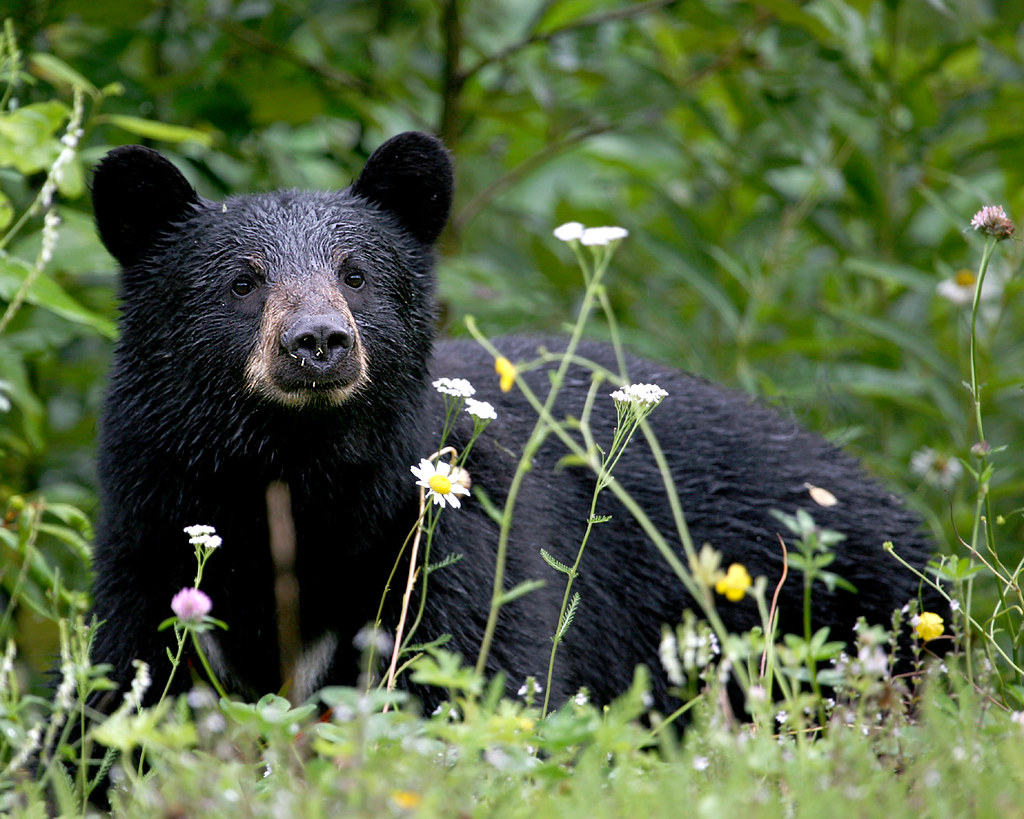Almanac: Ursa Minor

PhotoL Flickr.com. Creative Commons
I’ve heard from several people that bears have been on the prowl lately, not least by the Indy’s very own managing editor, whose bird feeders were wrecked by a bear about a week ago. But I like to write from personal experience, so I haven’t written about these fascinating creatures. Until now.
Last weekend I was chatting with a friend in my backyard late in the afternoon. I had a little chainsaw work to do in the front yard, so I walked around the corner of the house. There, standing in the middle of my driveway less than 20 feet away, was a medium-sized black bear, looking as surprised to see me as I was to see it. Surprised, but not terribly frightened. It eyed me balefully for a moment, then turned and ambled leisurely across my front yard.
I looked around for a mamma bear — which would be a potentially dangerous situation. But the bear seemed to be solo, so I followed it cautiously as it walked over to my neighbor’s yard. My neighbors are bird-lovers, but having heard the bear reports they had wisely taken in all their feeders. The bear clearly smelled the ghosts of the feeders, however, and spent some time poking around. Finding no satisfaction, it returned to my yard and headed for my black plastic compost bin at the rear of the property.
“Uh oh,” I thought. “My compost bin is about to have a really bad day.”
To my surprise, however, the bear walked right by the bin, possibly because my fondness for caffeine has resulted in a compost pile that smells more like the dumpster behind Amherst Coffee than a normal vegetable-and-food-scrap-laden compost pile.
In any event, the bear seemed completely at ease. I watched it sniff around and look for a way to get out of my backyard, which is enclosed by a low chain link fence. It reversed course, returned to my neighbor’s yard, and found a low spot in their back fence. With a hop and a lunge, it was gone, heading west toward Sunset Avenue.
This bear was not a cub, but neither was it full-grown. That suggests it was a young male, perhaps two years old. Cubs, which are usually born in late January or February while their mother is hibernating, stay with their family for about two years. Young females are allowed to occupy portions of the mother’s territory, but the males are sent packing. It is often these young males that wander into residential areas. It’s getting harder for these fellas to find areas not already “claimed” by an older male because there are an estimated 4,500 bears in Massachusetts and their numbers continue to rise.
People have written entire books about bears, so there’s way more to talk about than I have space for here. Instead I want to focus on the aspect of bears that struck me as I watched this one the other day: the way they walk.
There are three basic forms of “feet” among terrestrial animals: plantigrade (walking with the toes and metatarsals flat on the ground, as in humans), digitigrade (walking on the toes with the heel and wrist permanently raised, as in dogs and cats); and ungulograde (walking on the modified nails [i.e., hoofs] of the toes, as in horses and deer). Plantigrade feet are very stable because they have the largest surface area of the three types of feet (with the notable exception of elephants, which have hybrid plantigrade/digitigrade feet). But that stability makes plantigrade feet relatively bulky, and thus, hard to move rapidly. Digitigrade and ungulograde feet, being lighter, enable their owners to generally outrun any plantigrade animal.
Bears share the plantigrade foot form with humans, apes, and a smattering of other animals such as racoons, skunks, mice, porcupines, rabbits, and those prehensile possums I wrote about last week. Bears can certainly run — up to 30 miles per hour in a burst — but they don’t rely on speed for their survival so plantigrade paws work just fine.
After the bear we were watching departed, I worried that it would be hit by a car or truck. I contacted Amherst’s Animal Welfare Officer, Carol Hepburn, who says that in her 20 years on the job she’s never heard of a local bear being hit by a car. Not that it never happens anywhere, of course, but it seems as though bears have a better appreciation for the danger of moving vehicles than, say, possums.
Hepburn says she doesn’t mind hearing from people about bear sightings, although most of the time there is little to do except keep tabs on it. Only if a bear is near a school, daycare center, or heavily populated area will Hepburn call in the state environmental police to have the bear tranquilized and moved. She says transplanting a bear, or bears, has been needed only a couple of times in her career — most recently when a mother and two cubs were in a tree in downtown Amherst and didn’t feel like moving.
Hepburn says she’s never heard of anyone locally being injured by a bear, but suggests that, to reduce the risk of harm, people should remove bird feeders entirely in early spring. Don’t just empty them because, as we witnessed, the bears will smell the residue and knock down the feeder to investigate. Hepburn says she finds bears fascinating to watch, so she understands people’s interest, but she urges caution. “They’re wild animals.” We can’t predict what they’re going to do, but we can predict what we’ll do, so just use common sense,” she said.

I appreciate that the story is about bears, but I have to say, I love Carol Hepburn.